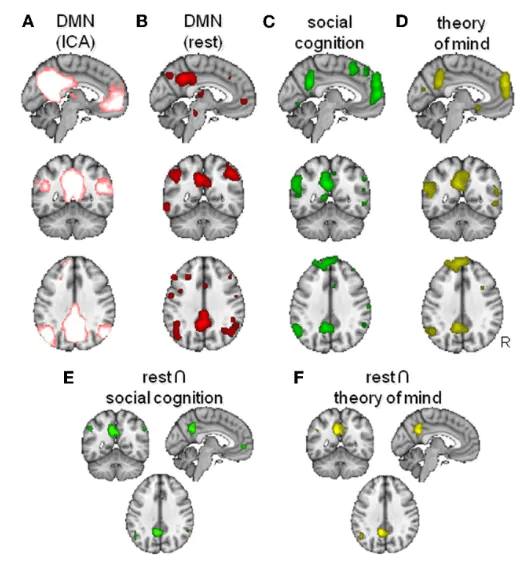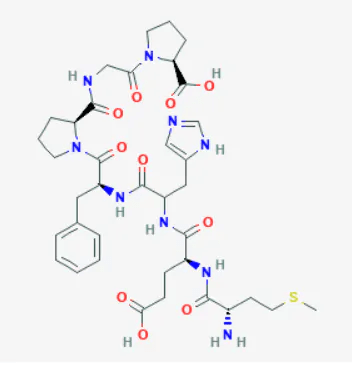How Semax Affects Resting Brain Structure
Research has shown that Semax can influence the neuronal network of the brain, particularly the default mode network (DMN). The DMN is a collection of brain regions that are active during rest and play a role in self-reflection, mind-wandering, and internal thought processes.
One study utilized resting-state functional magnetic resonance imaging (fMRI) to investigate the effects of Semax on the DMN. The results suggested that Semax modulates the activity and connectivity within the DMN, potentially impacting cognitive processes and brain function.
Furthermore, Semax has been found to have neuroprotective properties. It can protect and preserve neuron structure and function, potentially reducing the rate at which neurons are lost over time. This neuroprotective effect may contribute to Semax's potential benefits in treating cerebrovascular insufficiency and acute cerebral stroke.

Image showing the overlap of activation between the resting mode network and parts of the brain responsible social cognition.
Source: PubMed
Semax in the Setting of Stroke
This drug has demonstrated its effectiveness in the acute period of hemispheric ischemic stroke, influencing the restoration rate of damaged brain tissue. The molecular mechanisms underlying Semax's neuroprotective action in stroke therapy are still being studied.
In clinical trials, Semax has been added to conventional recovery therapy for patients recovering from ischemic stroke, reportedly accelerating the recovery process. It has also shown benefits in preventing disease progression in cerebrovascular disease and ischemic stroke.
Semax's therapeutic potential extends beyond stroke treatment. It has been investigated for its effects on cognitive impairment, dementia, inflammation of the optic nerve, and memory and cognitive disorders. The peptide's ability to protect brain cells and promote brain health makes it a subject of interest in various neurological conditions.
Semax and Gene Expression in the Brain
Semax has been found to impact gene expression in the brain. Several studies have investigated the effects of this drug on gene expression and how it relates to various brain functions:
Neuroprotection and Memory Storage: Research has shown that Semax increases the expression of genes associated with neuronal survival, selective attention, and memory storage.
Inflammation Regulation: Studies have evaluated the effect of Semax on gene expression related to inflammation. Semax was found to modulate the expression of key proteins involved in inflammation in the brain.
Ischemic Brain Injury: Semax has been found to increase the expression of genes involved in ischemic brain injury within 24 hours of the injury. This suggests that Semax may play a role in regulating gene expression in response to brain injuries.
Nerve Growth Factors: Experimental data indicates that Semax can increase the expression levels of nerve growth factors such as nerve growth factor (NGF) and brain-derived neurotrophic factor (BDNF). These factors are crucial for neuronal survival and growth.
Semax and Cognitive Performance
Several studies have investigated the impact of Semax on cognitive functions and memory:
Modulation of the BDNF/trkB System: Research suggests that Semax can influence cognitive brain functions by changing the activation and expression of the hippocampal BDNF/trkB system. Brain-derived neurotrophic factor (BDNF) plays a crucial role in synaptic plasticity and cognitive processes.
Improved Cognition: Semax has improved cognitive performance, including concentration, memory, and problem-solving abilities. It has been lauded for its exceptional benefits in enhancing cognitive functions.
Cognitive Enhancement in Healthy Individuals: While further research is needed, Semax may be an effective cognitive enhancer for healthy individuals. However, the existing science is inconclusive, and more research is required to determine its effectiveness.
Attenuation of Cognitive Impairment: Semax administration has been shown to attenuate cognitive impairment caused by acute stress and chronic stress factors.
Semax and Depression
Semax has a potential as a therapeutic option for depression. Studies have investigated the influence of Semax on the emotional state and behavior of animals, specifically rats.
One study found that the injection of a compound called CCK-4 induced anxiety and depression-like symptoms in rats. However, when Semax was administered, it normalized the disturbed behavior caused by the CCK-4 injection. This suggests that Semax might alleviate symptoms of anxiety and depression.
Emerging evidence suggests that Semax may have a therapeutic possibility for the treatment of depression. It has been suggested that a single application of Semax can have positive effects on depressive symptoms. Additionally, Semax has been found to reduce anxiety-like behavior, improve learning abilities, and normalize brain chemical levels impaired by certain factors.
Moreover, anecdotal reports and user experiences indicate that Semax, along with another peptide called Selank, may have anti-depressant and anti-anxiety properties. These peptides are being explored for their potential in alleviating mental health struggles.

